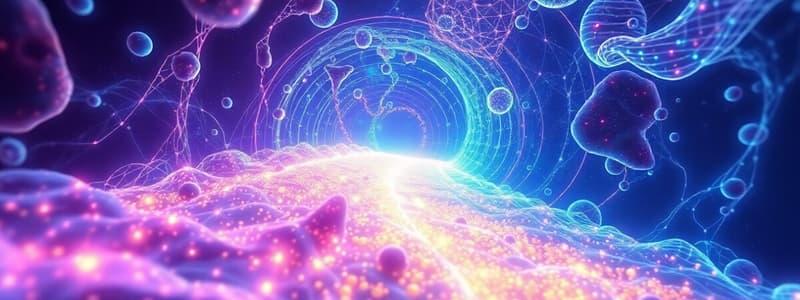Podcast
Questions and Answers
What is the primary energy source used in active transport mechanisms?
What is the primary energy source used in active transport mechanisms?
- Glucose
- ATP (correct)
- FADH2
- NADH
How many sodium ions are transported outside the cell for every two potassium ions transported inside by the sodium-potassium pump?
How many sodium ions are transported outside the cell for every two potassium ions transported inside by the sodium-potassium pump?
- 1
- 3 (correct)
- 2
- 4
Which process is characterized by the cell membrane enveloping a large particle to form a vesicle?
Which process is characterized by the cell membrane enveloping a large particle to form a vesicle?
- Exocytosis
- Pinocytosis
- Facilitated diffusion
- Phagocytosis (correct)
What is formed during pinocytosis when the cell membrane folds around liquid material?
What is formed during pinocytosis when the cell membrane folds around liquid material?
In what type of cells does exocytosis primarily occur?
In what type of cells does exocytosis primarily occur?
What is the primary characteristic of passive processes in membrane transport?
What is the primary characteristic of passive processes in membrane transport?
Which process involves the movement of water across a selectively permeable membrane?
Which process involves the movement of water across a selectively permeable membrane?
What mechanism allows large molecules like glucose to pass through the cell membrane without using energy?
What mechanism allows large molecules like glucose to pass through the cell membrane without using energy?
In which situation would active transport be necessary for the cell?
In which situation would active transport be necessary for the cell?
What are integral proteins primarily responsible for in facilitated diffusion?
What are integral proteins primarily responsible for in facilitated diffusion?
Which of the following statements is true regarding diffusion?
Which of the following statements is true regarding diffusion?
What is the role of ATP in active processes of membrane transport?
What is the role of ATP in active processes of membrane transport?
Which of the following processes would be categorized as an active transport mechanism?
Which of the following processes would be categorized as an active transport mechanism?
What is osmosis primarily concerned with in terms of molecular movement?
What is osmosis primarily concerned with in terms of molecular movement?
What type of solution causes a cell to swell due to water influx?
What type of solution causes a cell to swell due to water influx?
What happens to the osmotic pressure when solute concentration increases?
What happens to the osmotic pressure when solute concentration increases?
Which process involves the movement of solvents due to hydrostatic pressure?
Which process involves the movement of solvents due to hydrostatic pressure?
What is the primary role of dialysis?
What is the primary role of dialysis?
In which scenario would a cell lose water rapidly?
In which scenario would a cell lose water rapidly?
What type of membrane is required for osmosis to occur?
What type of membrane is required for osmosis to occur?
Which of the following accurately describes filtration?
Which of the following accurately describes filtration?
Flashcards
Diffusion
Diffusion
The movement of molecules from an area of high concentration to an area of low concentration.
Lipid Soluble Diffusion
Lipid Soluble Diffusion
Molecules that can dissolve in the cell membrane and pass through it directly.
Channel Mediated Diffusion
Channel Mediated Diffusion
Movement of water and ions through special protein channels in the cell membrane.
Diffusion Equilibrium
Diffusion Equilibrium
Signup and view all the flashcards
Facilitated Diffusion
Facilitated Diffusion
Signup and view all the flashcards
Osmosis
Osmosis
Signup and view all the flashcards
Water Potential
Water Potential
Signup and view all the flashcards
Isotonic Solution
Isotonic Solution
Signup and view all the flashcards
Hypotonic Solution
Hypotonic Solution
Signup and view all the flashcards
Hypertonic Solution
Hypertonic Solution
Signup and view all the flashcards
Filtration
Filtration
Signup and view all the flashcards
Dialysis
Dialysis
Signup and view all the flashcards
Active Transport
Active Transport
Signup and view all the flashcards
Sodium-Potassium Pump
Sodium-Potassium Pump
Signup and view all the flashcards
Endocytosis
Endocytosis
Signup and view all the flashcards
Phagocytosis
Phagocytosis
Signup and view all the flashcards
Pinocytosis
Pinocytosis
Signup and view all the flashcards
Exocytosis
Exocytosis
Signup and view all the flashcards
Secretion
Secretion
Signup and view all the flashcards
Study Notes
Passive Transport
-
Diffusion: Movement of molecules from high to low concentration.
- Types:
- Lipid soluble: Molecules dissolve in the lipid bilayer (e.g., oxygen, carbon dioxide, fatty acids, alcohol).
- Channel mediated: Water and ions move through membrane protein channels (e.g., Na+, K+, Cl-).
- Equilibrium: Movement continues until the concentration gradient is equal on both sides.
- Types:
-
Facilitated diffusion: Movement of larger molecules through membrane proteins that act as carriers.
- Example: Glucose transport.
- No energy required: Moves from high to low concentration.
-
Osmosis: Water movement across a selectively permeable membrane from a region of high water concentration to a region of low water concentration.
- Driven by: Water potential (concentration gradient).
- Types of solutions:
- Isotonic: Same solute concentration inside and outside the cell.
- Hypotonic: Lower solute concentration outside the cell, causing water to move into the cell (swelling).
- Hypertonic: Higher solute concentration outside the cell, causing water to move out of the cell (shrinking).
-
Filtration: Movement of water and small solutes across a membrane due to pressure difference.
- Example: Kidney filtration where blood pressure forces water and small molecules like urea through blood vessel membranes.
-
Dialysis: Diffusion of solutes across a selectively permeable membrane that allows small molecules to pass while retaining larger ones.
Active Transport
-
Active Transport: Movement of substances against their concentration gradient, requiring energy (ATP).
- Example: Sodium-potassium pump, which moves Na+ out of the cell and K+ into the cell, creating an electrical potential across the membrane.
-
Endocytosis: Taking in large molecules or particles.
- Phagocytosis: "Cell eating" where the cell membrane engulfs solids and forms a phagocytic vesicle.
- Pinocytosis: "Cell drinking" where the cell membrane engulfs liquids and forms a pinocytic vesicle.
-
Exocytosis: The release of substances from the cell by reverse endocytosis.
- Secretion: Examples are hormones and neurotransmitters.
Studying That Suits You
Use AI to generate personalized quizzes and flashcards to suit your learning preferences.


